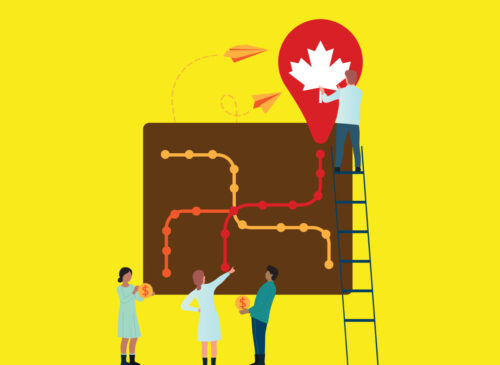As international students become an integral part of the Canadian postsecondary education landscape, Soma Chatterjee asks: How did immigration, labour markets, and education get tied together, and how can we untangle their influence to improve student conditions? This piece originally appeared on the Academic Matters website. It has been updated to reflect the recent policy changes to the international higher education program.

For the 2023-24 year, most arts and science programs at Toronto’s York University and Toronto Metropolitan University charge international students approximately $33-35,000 in tuition and ancillary fees. At the University of Toronto, this figure reaches to an astronomical $60,000 per year. The figures for the same programs in each of these institutions range between $6,000 to $11,000 per year for domestic students.
When it comes to colleges, international students, paying between $8,000 to $20,000 per year, were recently reported to be outpacing government funding of colleges in Ontario.
These are outrageously high amounts. They are all the more outrageous when international students have to navigate a postsecondary system that is interested in the revenues they generate but is ill-equipped to support them, and a society just waking up to their basic human needs.
Stories of international students’ exploitation in the labour and housing markets are currently all over the Canadian news media. Once hailed by policymakers as immigrants of the future who are ready to take on the world by virtue of their compatibility with the Canadian labour market, they face tougher job prospects and are trailing behind Canadian-born graduates from the same postsecondary programs.
At best, news media and popular discussions cast international students as gullible, desperate for a first-world experience and ill-prepared for Canadian housing and employment realities. At worst, they are portrayed as malicious, cheating their way into the study-migration pathway. Most egregiously, they have been blamed for Canada’s housing crisis. This narrative persists despite evidence that capping student visa numbers to address the crisis will not work and that the housing crisis more accurately results from a nexus of developers, investors, varied levels of government, zoning laws, and central bank policies.
Such an international student cap was indeed introduced this winter. Announcing a two-year intake cap and a return to a 20-hour-per-week work permit, Federal Immigration Minister Marc Miller invoked systemic abuse of the international education program by “bad actors,” and cited pressure on housing, healthcare, and other services due to the increased number of international students. He also claimed these “decisive measures” will ensure the integrity of “our immigration system.”’
The reality of international students’ lives and their interactions with postsecondary, health, and housing systems are much more complex than what partisan political policies and popular portrayals suggest.
The reality of international students’ lives and their interactions with postsecondary, health, and housing systems are much more complex than what partisan political policies and popular portrayals suggest.
So how did a population actively courted to help Canada perform in the global race for skills, and considered vital to its post-pandemic recovery, come to experience such deplorable conditions, criminalization, and policy measures aimed to curtail their arrival and presence in this country?
To answer that question and find accountability for this situation, we need to look at the history of labour recruitment strategies that encouraged the students to be here in the first place.
International students appeared on the Canadian labour and migration policy radar due to an intense global competition for mobile workers.
International students appeared on the Canadian labour and migration policy radar due to an intense global competition for mobile workers. For close to twenty years, Canada has been rearranging immigration, work permit, and visa policies to brand itself as a destination of choice for international students. In 2002, the federal government published Knowledge Matters, Canada’s first national Innovation Strategy (a project similar in significance to the 1991 report of the Social and Economic Council of Canada that advocated for a target immigration intake of one percent of Canada’s population). Published in two parts—Achieving Excellence: Investing in People, Knowledge and Opportunity, and Knowledge Matters: Skills and Learning for Canadians—the strategy declared “high skill” as a national priority and international graduates as a potential source of labour and a “significant economic benefit” to host institutions and local communities.
The governing federal Conservative Party, elected in 2006, embraced the rhetoric of fixing a “broken immigration system” and facilitated the restructuring of immigration policies toward recruiting skilled immigrants with Canadian experience.
This turn toward the job-ready immigrant further intensified the focus on international students. Canada’s federal and provincial governments signed a series of agreements to promote Canada as an attractive international study destination. This was followed by the creation of the federal Skills Research Initiative, then led by Human Resource and Skills Development Canada and Industry Canada. This project was instrumental in shaping the program of Canadian Experience Class (CEC), a two-tier permanent residency program that followed in 2008 into which international students were encouraged to apply for after first obtaining Canadian work experience through the postgraduate work permit. Prior to its introduction, international students had to leave the country after graduating and re-apply for permanent residency; a practice which came to be considered both “madness” and a lost opportunity.
Between 2009 and 2013, the percentage of students transitioning from student visas to permanent residency status through CEC was 93 per cent for principal applicants and 121 per cent for the spouse/dependent category. Indeed, the program was considered a potential game-changer for solving the problem of matching internationally trained, skilled immigrants with jobs in the Canadian labour market, after receiving (and paying for) a Canadian education.
Nearly a decade of frenzied policymaking culminated in the first International Education Strategy (2014-19), which declared the federal government’s goal to increase the number of international students from a quarter million to more than 450,000 by 2022, a number it exceeded very quickly. At the end of 2022, the Canadian Bureau of International Education reported that 807,750 international study permits were issued at all levels, the majority at the postsecondary level. The newly announced intake cap will result in approximately 360,000 approved study permits, a decrease of 35 per cent from 2023.
Amidst sensational media coverage of the desperate conditions faced by international students and partisan policy decisions that cast them as problems to be rid of or vulnerable subjects in need of protection, the political and economic conditions that shape this phenomenon are missing. These are conditions we all operate within. International students in Canada are facing a nationalist backlash that is both contemporary and has its roots in the capitalist, colonial racism that founded the country. It is dangerous to ignore this—and invaluable to understand and acknowledge it. As poet and writer M. NourbeSe Philip argues, in Canada, there has been a national commitment—indeed, an injunction—to forget the country’s racist history.
As the exploitation of international students continues to make headlines and capping their numbers is couched in a politics of care and concern, we would do well to remember that tensions between a white national imaginary and “alien” labour importation has been a key dynamic in Canadian nation-building since the country as we know it now was founded and even more so following the liberalization of immigration policies in 1962. Liberalization, the proverbial “opening of the gates,” allowed large numbers of skilled immigrants from global south countries into Canada, particularly from the 1980s onward. Shortly afterward, media discourses of “taxi-driving PhDs and pizza-delivering MDs” led to more academic research and public policy attention on “the problem” of immigrants’ labour market integration.
The incongruence between immigrants’ skills and the jobs they could find in Canada was a result of employers’ and regulatory bodies’ demand for Canadian experience that has been conceptualized as a “gatekeepers’ anxiety” and an instrument of nation-building even in the apparently de-territorialized skilled labour market. Similarly, rigorous scholarship has uncovered how the Non-Immigrant Employment Authorization Program keeps temporary migrant workers outside of the realms of Canadian citizenship by its very design. This country has a long history of recruiting racialized immigrant labour in its quest for economic prosperity while devaluing and expelling them from rights-bearing membership in Canadian societies.
What is happening to international students is no exception to this historic pattern.
What is happening to international students is no exception to this historic pattern. Currently, they face employment exploitation including low wages and poor working conditions, alongside a severe lack of appropriate housing. Under the new measures, they will have to demonstrate access to $20,635 as opposed to $10,000 previously. How is this setting students “up for the success they hope for”?
At the time of writing this update, discussions in the postsecondary sector seem fixated on the financial implications of the intake cap on their operations, importantly exposing the Faustian bargain the institutions struck while claiming to promote Canada as a destination of choice for the world’s brightest and the best. International students pump billions of dollars into the Canadian economy, supplementing—even standing in for public funding—particularly in the large migrant-receiving provinces such as Ontario and British Columbia. As Roopa Desai Trilokekar and Lisa Brunner write in University Affairs: “The Government of Canada would not have allowed Canada’s higher education system to have the highest proportion of international student enrollments globally if they got nothing out of the deal.”
As an educator concerned about the rampant business model of higher education, I welcome the difficult conversations about public and private funding this situation has opened up. I particularly welcome career colleges coming under the policy radar. However, as we know, predatory practices extend throughout the postsecondary sector. This points to systematic bleeding of the public education system starting in the 1990s or even earlier, by some accounts. It should be noted that nowhere in these policy re-visionings do we see a serious acknowledgement that the public education budget needs replenishing or that we clearly have lost track of the core values of higher education, leading to the policy problem of what Trilokekar and Brunner call “edugration.” As such, I agree with Yvonne Su and Leah Hamilton’s critique of the recent measures in The Conversation as “overly simplistic, untrue, and xenophobic,” that adds up to “an abdication of responsibility” on the part of the federal government.
International students, as we know, have not taken their circumstances lying down. They have collectively organized—under conditions of heavy debt and workloads, we must remember— against labour exploitation, threats of deportation and possible inadmissibility, deplorable housing conditions, scapegoating, and criminalization. Their resistance to situations of precarity and exploitation has been admirable. It remains to be seen how they respond to the newly introduced policy strictures. Notably, professional programs are left out of the measures, as are work permits for graduate and doctoral students and their spouses. This will have significant impacts on students who undertake overseas education as a pathway for family migration. The moves seem well positioned to deepen class divisions and solidarity among a cohort of students known to be highly politically active.
International higher education in Canada, as I show in a forthcoming book, came to be entangled with migration to set immigrants up for success and for the skilled migration program to succeed. It now seems imperative to disentangle the two to set international students up for success and for the study migration program to retain its integrity.
Those of us who care for labour and migrant justice, and the core values of international higher education, have a responsibility to push back against this blatant scapegoating of immigrants and students for what are clearly repetitive and spectacular failures of policy imaginations. Moral outrage is not nearly good enough. We need to expose and articulate the pattern of recruiting racialized labour only to expel them from national membership as foundational to this nation. We must state, unequivocally, that what is happening is not anomalous to Canada, but is typical to the model of racialized western nation-building it practices. Only then we can envision policy pathways that are robust, ethical, and far-sighted.










